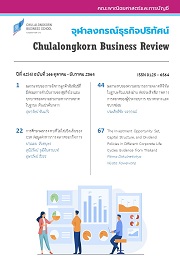The Investment Opportunity Set, Capital Structure, and Dividend Policies in Different Corporate Life Cycles: Evidence from Thailand
Main Article Content
Abstract
The purpose of this paper is to investigate the relationship between the investment opportunity set (IOS), capital structure, and dividend policy in Thailand, which is one representative of emerging countries. The paper extends prior literature on the IOS by examining the impact of the corporate life cycle on the relationship between IOS and financial policies. The analysis is based on the annual data of firms listed in the Stock Exchange of Thailand between the years 2000 and 2019. The results show a positive relationship between IOS and the leverage ratio, which provides evidence in favor of the signaling theory. However, firms with high growth opportunities are likely to pay lower dividends since they have lower free cash flows. Moreover, the results reveal that corporate life cycle has positive moderating effects on the relationship between IOS and leverage ratio. This can be interpreted as firms in the growth and maturity stages tend to use more debt funding compared to firms in the earlier, shake-out, and decline stages of the life cycle. Adversely, the moderating effects of corporate life cycle on the relationship between IOS and divided policy is not significant.
Article Details
Opinions and discussions in papers published by the Creative Business and Sustainability Journal (CBSJ) are deemed as personal opinions and the responsibility of the writers. They are not the opinions or responsibility of the Chulalongkorn Business School of Chulalongkorn University.
Papers, content, information etc. appearing in the Journal are deemed to be the copyright property of the Chulalongkorn Business School of Chulalongkorn University. Anybody or any organization that wishes to publish any part of them or use them in any way must obtain written permission from the Chulalongkorn Business School, Chulalongkorn University.


